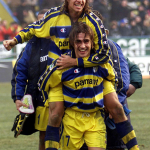
What if Champion comes back to producing football jerseys?
After the rebirth of the American brand, a return to the football fields is not unthinkable
January 14th, 2021
Once upon a time, in the 1990s, there was the Parma Calcio of Crespo, Ortega, Thuram and Gigi Buffon, in particular distinguished by his jersey made by Champion brand. The American brand, together with this yellow-blue uniform, has created a combination impressed in the collective memory as a symbol of oversized aesthetics. Years after that era of splendor for Serie A, Parma Calcio's jerseys still remain an object of worship for the aesthetics of the Italian championship, and the Champion logo with them. The last football shirt produced by Champion dates back to 2010: at that time, the brand signed the uniforms of the Wales national team. Before, Wigan Athletic, Sochaux and of course Parma had collaborated with the star and stripes brand, between the 90s and the first decade of 2000.
The last Champion's football jersey dates back to 2010: the mark was signing the shirts of Galles then. Before then, Wigan Athletic, Sochaux and obviously Parma collaborated with the stars and stripes brand, between the 90s and the first decade of 2000s. Champion's shirts were a gold standard in the football apparel, yet they especially had a stylistic versatility even outside the pitch. We can find some palpable examples in the basket or American football jerseys. Let's think to Manu Ginobili: one of the first images of the former San Antonio Spurs that surface our mind pictures him on the Unipol Arena's parquet, Virtus Bologna's home until 2017, and of which is impossible to forget the black and white shirt sponsored by Champion, with Kinder as the main sponsor, in the early 2000s. Even the jerseys of the Italian basket National team signed by Champion are still one of the most precious relics for the fans, not to mention the NBA shirts of the 90s, where unfortunately the Champion logo was only on the internal label of the shirt.
Champion's jerseys were a gold standard in football, but above all they had stylistic versatility even off the field. A clear example of this are football and basketball jerseys. At exapmles, the one of Manu Ginobili: among many, there is a historical photo of the former San Antonio Spurs that portrays him on the parquet floor of the Unipol Arena at the beginning of 2000, in which it is impossible not to remember the Virtus Bologna shirt sponsored by Champion and with Kinder as main sponsor. Even the uniforms of the Italian national basketball team were signed by Champion, and are among the most precious relics for basketball fans, not to mention the NBA tank tops of the 90s - unfortunately, Champion's logo was on the internal label of the jersey only.
How did it happen that Champion left the football pitches?
The cause is, banally, attributable to the life cycle of a trend. For all of the 1990s, Champion was a forefather of streetwear. It was worn by rappers, athletes played with uniforms signed by the American brand, and the boys, of course, were inspired by them in everything, especially in the clothes to wear. Then the trend just waned. With the onset of the new millennium, Champion suddenly lost his appeal. The tastes of influencers have turned towards a different and less sporty style; the competition has also become fierce on the performance side - the revolution brought by Kappa in 2000 with KOMBAT jersey has streamlined the fits of the uniforms and Champion has not been able to homolote - and as a result, the brand has stopped being requested as sports sponsor. Champion, founded by the Feinbloom brothers in 1919, continued to produce its own items, but the hype for the brand was zero. Until fashion turned round again.
In 2017, Champion recorded sales growth of 33%, which became 40% a year later. The reason for this growth is to be found in the return of oversize cuts among sportsmen - stimulated by nostalgia for the 90s -, in a wise use of social media, which in almost five years has seen Champion reach 5.6 million followers on Instagram starting from just over 200 thousand. But most importantly, the explosion of streetwear has brought brands like Champion, FILA and Kappa to the virtual shelves of Farfetch and SSENSE and into Instagram windows. In this sense, Champion has also been facilitated by brands such as Vetements, which brought the brand to the catwalk in 2016, and Supreme, which has collaborated with Champion several times, also injecting it into the niche market. Rappers, designers and influencers have started dressing Champion again and the brand's prices have risen. In addition, the brand's large presence of vintage garments winks at Generation Z's interest in the circular economy. In fact, the cozy look that the brand had in the 90s can be replicated today by the sons of those who dressed Champion thirty years ago, reusing their parents' clothes.








































.png)


.jpg)


.jpg)
.jpg)

.jpg)








.jpg)




































